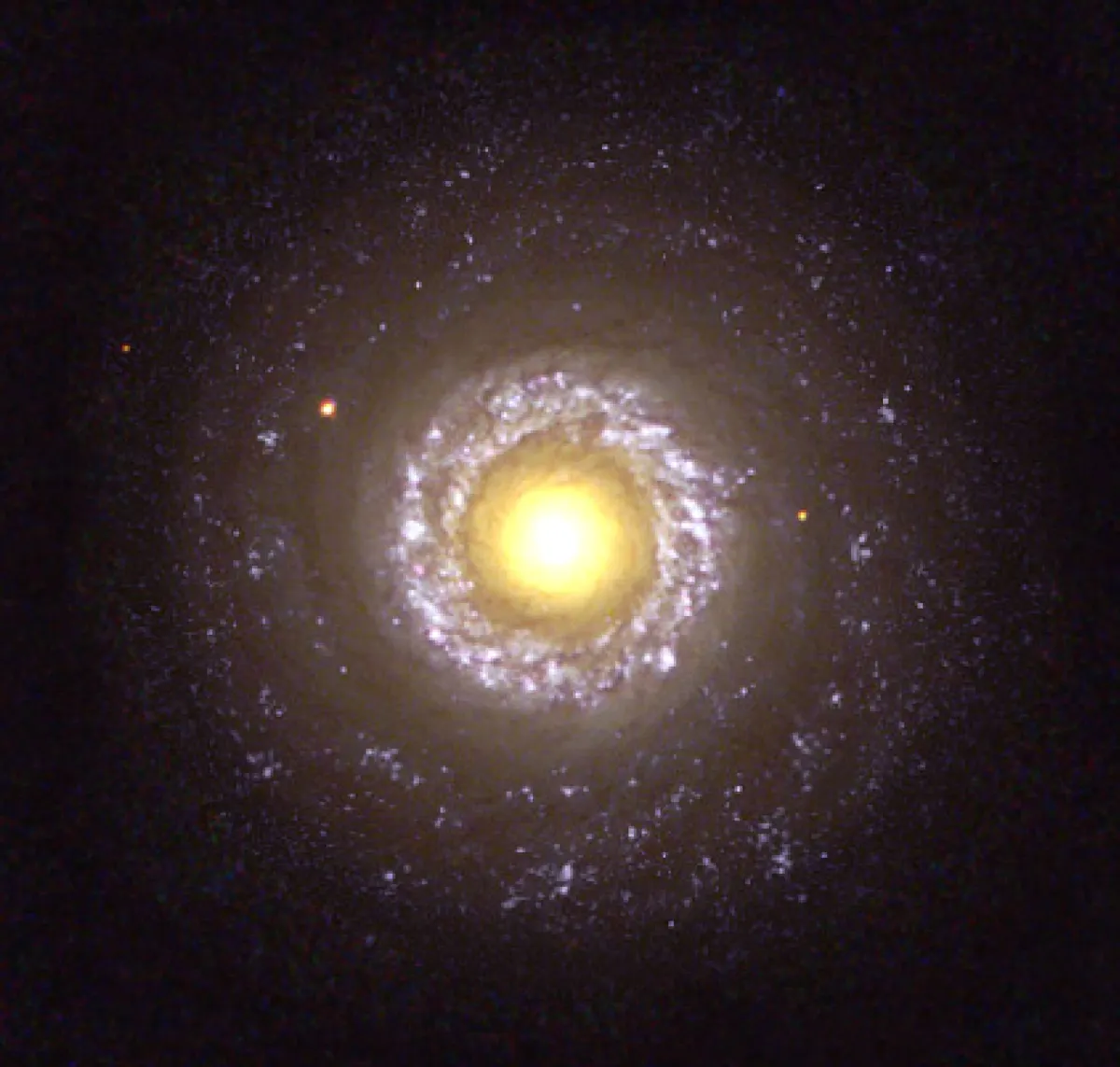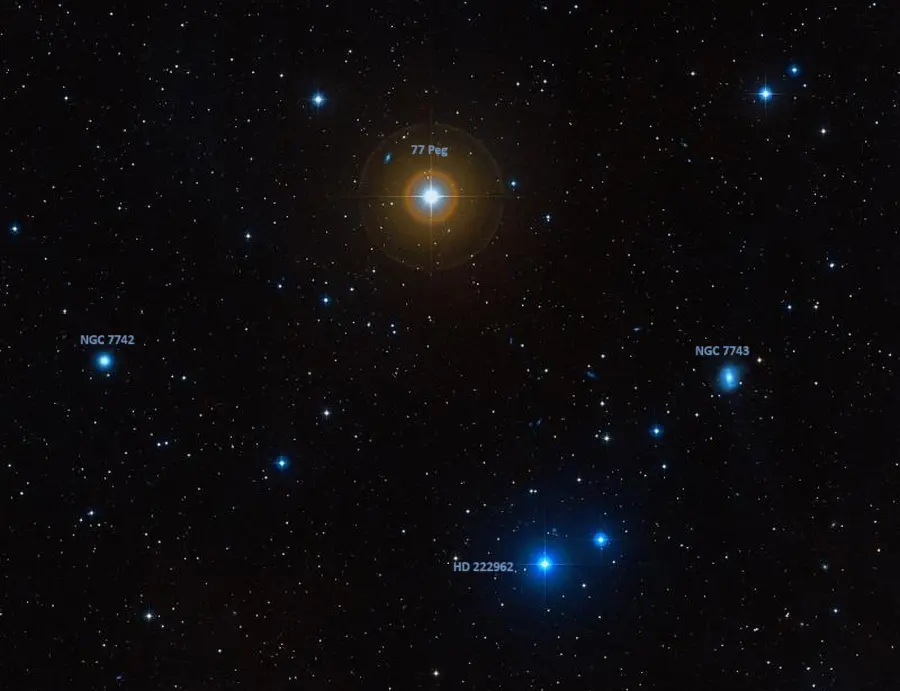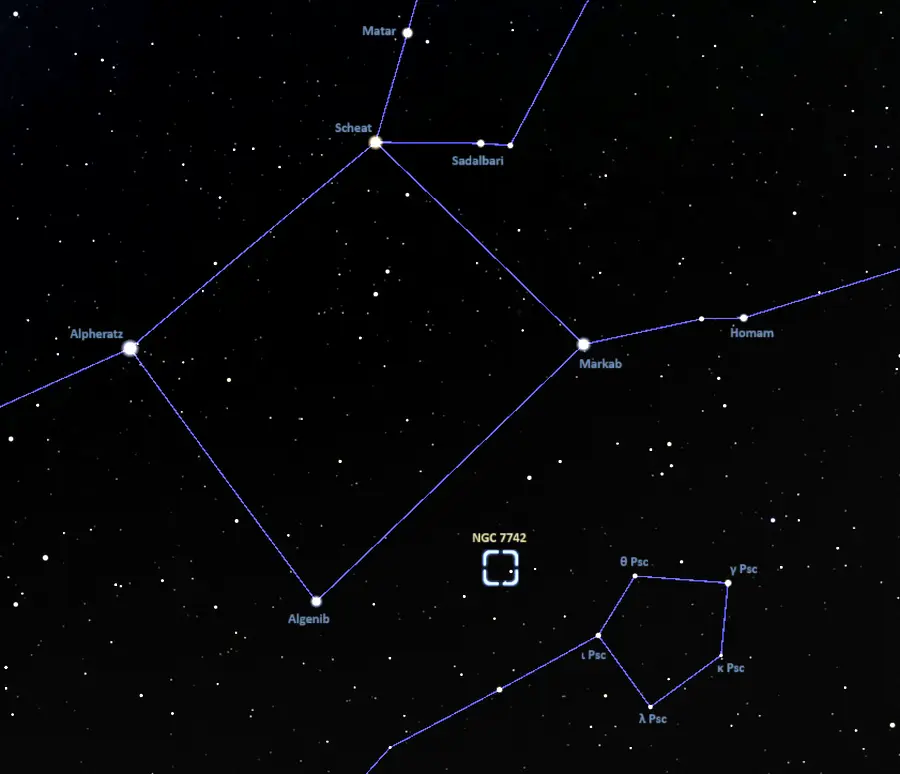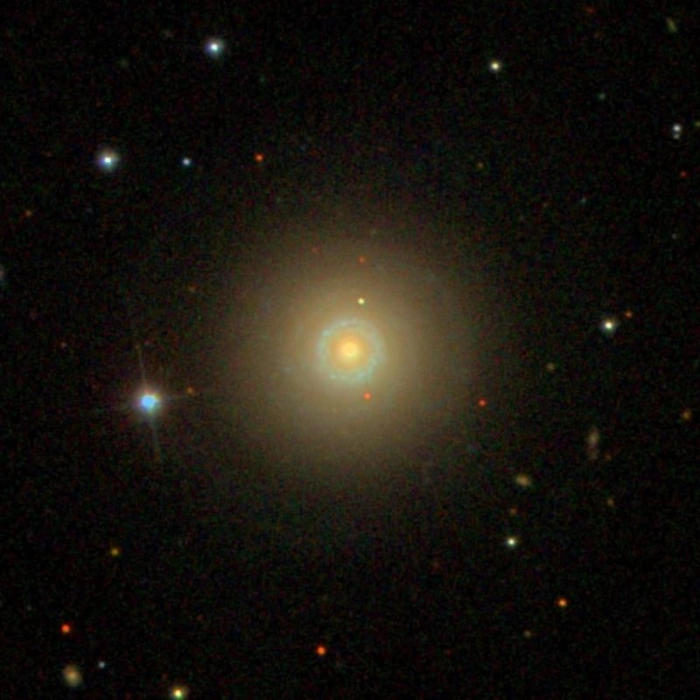The Fried Egg Galaxy is an unbarred spiral galaxy located approximately 72.4 million light-years away in the constellation Pegasus. It has an apparent magnitude of 12.35. It is listed as NGC 7742 in the New General Catalogue.
With an estimated size of around 50,700 light years, the unbarred ring galaxy is much smaller than the Milky Way. It appears face-on and has an angular size of 1.778 by 1.698 minutes of arc. It was nicknamed the Fried Egg Galaxy because its bright yellow core resembles the yolk of a fried egg.
The galaxy has a prominent ring that has long been a target of study because galaxies are believed to need bars to produce a ring structure like the one in NGC 7742. Gravitational forces in galactic bars typically form rings by moving gas to the ends of the bars. However, the absence of a bar structure in the Fried Egg Galaxy leaves the mechanism that produced the ring uncertain.

What may first appear as a sunny side up egg is actually NASA Hubble Space Telescope’s face-on snapshot of the small spiral galaxy NGC 7742. But NGC 7742 is not a run-of-the-mill spiral galaxy. In fact, this spiral is known to be a Seyfert 2 active galaxy, a type of galaxy that is probably powered by a black hole residing in its core. The core of NGC 7742 is the large yellow “yolk” in the center of the image. The lumpy, thick ring around this core is an area of active starbirth. The ring is about 3,000 light-years from the core. Tightly wound spiral arms also are faintly visible. Surrounding the inner ring is a wispy band of material, which is probably the remains of a once very active stellar breeding ground. Image credit: AURA, STScI, NASA, Hubble Heritage Project (STScI, AURA) (PD)
While rings are usually found in barred spiral galaxies, there are other unbarred ring galaxies that are exceptions to the rule. These include the spiral galaxies NGC 7217 in the constellation Pegasus and NGC 278 in Cassiopeia, and the lenticular galaxy NGC 7702 in Phoenix. Like NGC 7742, each of these galaxies hosts a spectacular nuclear starburst ring.
The ring in NGC 7742 has a mass of around 6 x 109 M⊙, which is large with respect to the galaxy’s total stellar mass of 5.9 x 1010 M⊙.
One possible explanation for the formation of the ring is a merger with a smaller gas-rich dwarf galaxy. In 2005, O. K. Sil’chenko and A. V. Moiseev studied the Fried Egg Galaxy and the unbarred ring galaxy NGC 7217. They proposed that a minor merger in the past was responsible for the peculiarities observed in these galaxies, including the nuclear star-forming rings and the absence of global bars. The merger may have triggered oval distortions of the galaxies’ stellar disks, and the star formation in the ring is most likely fuelled by gas accreted from the smaller companion.
The gas in the starburst ring in NGC 7742 rotates in the opposite direction to the stars in the galaxy. This indicates a recent merger. The gas densities in the ring are low, which is typical for massive H II regions.
The star clusters in the ring are evolving rapidly. In 2012, a study by Richard de Grijs and Peter Anders of the Kavli Institute for Astronomy and Astrophysics, Peking University, Beijing, China, found that the disruptive environment in the starburst ring may considerably speed up dynamical star cluster disruption. The astronomers suggested that the disruption rate at young ages may be the result of the high density of ring and the shear caused by the counterrotating gas disk.
In 2017, observations with the Multi-Unit Spectroscopic Explorer (MUSE) on the Very Large Telescope (VLT) revealed two separate stellar populations: old stars that rotates in the opposite direction to the gas and young stars in the ring that rotate with the gas. The counter-rotation between the stars and the gas extends beyond the ring region. The results indicate that the ring was produced in a minor merger event that occurred 2 – 3 billion years ago.
The study authors, led by Thomas P. K. Martinsson of the Centro de Astrobiología (CAB, CSIC-INTA), Madrid, Spain, found that the young stars were predominantly in the ring and disk of NGC 7742, where they account for 8 and 6 percent of the total stellar mass. These stars are less than 1 billion years old. The youngest detected stars in NGC 7742 are less than 15 million years old. Intermediate-age stars contribute 14 percent to the stellar mass in the ring.
NGC 7742 is classified as a type II Seyfert galaxy. It has an active galactic nucleus (AGN), a bright core, and it appears bright in the infrared band.
The galaxy has a LINER (low-ionization nuclear emission-line region) at its core. The gas at the galaxy’s centre is ionized either by an active galactic nucleus with a supermassive black hole or by star formation regions.
In 2023, S. Zamora found a mean mass of 3.5 × 104 M⊙ for the ionizing clusters that power the H II regions in the ring of NGC 7742.
The Simbad database lists NGC 7742 as a galaxy in a pair of galaxies. The galaxy NGC 7743 is the other half of the pair. Shining at magnitude 11.4, NGC 7743 is brighter than NGC 7742. With an apparent size of 3.1 arcminutes, it also appears larger. Some sources classify it as a barred spiral galaxy, while others list it as a lenticular galaxy. NGC 7743 lies approximately 79 million light years away. Both galaxies appear near the magnitude 5.09 red giant 77 Pegasi.

NGC 7742 and NGC 7743, ESO/Digitized Sky Survey 2 (CC BY 4.0)
Facts
The Fried Egg Galaxy was discovered by the German-born British astronomer William Herschel on October 18, 1784. Herschel discovered the sibling galaxy NGC 7743 on the same night.
Danish astronomer John Louis Emil Dreyer, who compiled the New General Catalogue in 1888, described the object as “considerably bright, considerably small, gradually much brighter middle, 12th magnitude star 72 arcsec to east.”
The Fried Egg Galaxy has hosted two supernovae observed in the recent decades. The supernova SN 1993R was detected during the Leuschner Observatory Supernova Search (LOSS) on June 2, 1993. It was classified as a type II supernova and had an apparent magnitude of 17. It appeared 8 arcseconds east and 5 arcseconds north of the galaxy’s nucleus.
SN 2014cy was a type IIP supernova spotted by Ken’ichi Nishimura on August 31, 2014. It shone at magnitude 16.2 and was located 1 arcsecond east and 12 arcseconds north of the galaxy’s centre.
Location
The Fried Egg Galaxy lies in the northern constellation of Pegasus. It appears in the region between the Great Square of Pegasus and the Circlet of Pisces. It can be found close to the line extended from Gamma Piscium through Theta Piscium in the Circlet, near the red giant 77 Pegasi.
The best time of the year to observe the Fried Egg Galaxy and other deep sky objects in Pegasus is during the month of October, when the Great Square dominates the evening sky. At declination +10°46’, NGC 7742 is visible from virtually anywhere for at least part of the year.

Location of the Fried Egg Galaxy (NGC 7742), image: Stellarium
Fried Egg Galaxy – NGC 7742
| Constellation | Pegasus |
| Object type | Spiral galaxy |
| Morphological type | SA(r)b, LINER/H II |
| Right ascension | 23h 44m 15.7534099368s |
| Declination | +10° 46′ 01.533226872″ |
| Apparent magnitude | 12.35 |
| Apparent size | 1.778’ x 1.698’ |
| Size (estimated) | 50,700 light-years (15,550 parsecs) |
| Distance | 72.4 ± 6.2 million light-years (22.20 ± 1.90 Mpc) |
| Redshift | 0.005553 ± 0.000010 |
| Heliocentric radial velocity | 1,663 ± 1 km/s |
| Galactocentric velocity | 1,809 ± 6 km/s |
| Names and designations | Fried Egg Galaxy, NGC 7742, LEDA 72260, PGC 72260, UGC 12760, MCG +02-60-010, KUG 2341+104, CGCG 432-023, IRAS 23417+1029, IRAS F23417+1029, 2MASX J23441571+1046015, UZC J234415.8+104601, PSCz Q23417+1029, Z 432-23, Z 2341.8+1030, SDSS J234415.75+104601.5 |

Fried Egg Galaxy (NGC 7742), credit: Sloan Digital Sky Survey (SDSS) (CC BY 4.0)